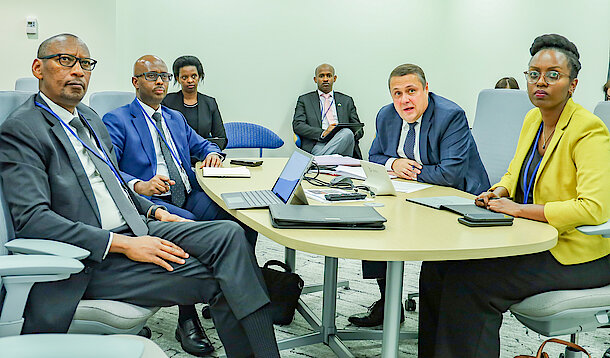Rwanda continues to demonstrate impressive economic resilience amid challenging global conditions, according to the International Monetary Fund (IMF).
The IMF shared its assessment on Tuesday, October 22 after concluding a two-week mission in Rwanda to review the country’s economic policies and reforms under several financing arrangements.
The mission, which ended on October 22, involved discussions between the IMF team, led by Ruben Atoyan, and Rwanda’s Ministry of Finance and Economic Planning.
The review focused on the country’s progress under the Policy Coordination Instrument (PCI), the Resilience and Sustainability Facility (RSF), and the Standby Credit Facility (SCF).
The IMF forecasts Rwanda’s real GDP growth at 8.3% in 2024, driven by robust performance in services and construction sectors, as well as a recovery in food crop production. The IMF noted that inflation remains stable within the central bank’s target range, thanks to appropriate monetary policies and favourable food prices.
Despite some depreciation of the Rwandan Franc—which dropped by 6.6% against the US dollar—the IMF considered this a necessary adjustment to maintain external stability. International reserves remained healthy, covering 4.5 months of imports as of mid-2024, offering a cushion against economic shocks.
“Macroeconomic policy performance through mid-2024 has aligned with program objectives under the PCI/SCF arrangement,” said Atoyan.
He also highlighted Rwanda’s progress in enhancing public investment transparency and strengthening foreign exchange market functionality.
Mr. Atoyan emphasised the Rwandan government’s commitment to climate-related reforms under the RSF framework. The country is advancing climate budget tagging, improving the resilience of public investments, and developing green taxonomy standards. Sustainability disclosure standards are also on track to be implemented in the coming weeks.
The IMF recognized that recurrent economic shocks in recent years have complicated the government’s efforts to rebuild policy buffers. Fiscal consolidation has proceeded slower than anticipated, contributing to an increase in the public debt-to-GDP ratio.
In response, the government reiterated its strategy to focus on concessional financing while implementing a medium-term revenue strategy to stabilise public finances.
Efforts to enhance the governance of state-owned enterprises and manage their fiscal risks will also continue as part of broader economic reforms.
Upon completing the review in December 2024, Rwanda is expected to receive US$95.9 million under the RSF and US$89.0 million under the SCF to support ongoing reforms.
According to the latest GDP figures announced on Monday, September 16, by the National Institute of Statistics (NISR) and the Ministry of Finance and Economic Planning, Rwanda’s economy grew by 9.8 per cent in the second quarter of 2024, mainly driven by the services sector which contributed 47 percent to Gross Domestic Product (GDP), official data shows.
It worh noting that Rwanda has maintained consistent economic growth over the past two decades, averaging 8% annual GDP growth. Before the pandemic, the country recorded double-digit growth in the final two quarters of 2019.
Since the early 2000s, domestic tax revenue increased twentyfold, while the national budget expanded fourteenfold. Rwanda’s dedication to reforms has positioned it as the second-best place to do business in Africa.
Rwanda aims to become a middle-income country by 2035 and a high-income country by 2050 through the National Strategy for Transformation (NST-2). This five-year development plan focuses on achieving Sustainable Development Goals (SDGs) through sectoral strategies promoting inclusive growth.
In recognition of Rwanda’s economic momentum, the United Nations’ World Economic Situation and Prospects 2024 report released early this year, ranked Rwanda third among the top ten African countries expected to achieve high growth in 2024. Rwanda’s projected 7.6% growth rate follows Libya’s 9.2% and Senegal’s 7.6%.

